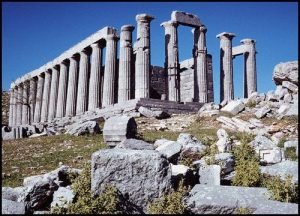The Parthenon of the Peloponnese
 They call it the “Parthenon of the Peloponnese”. The columned temple of Apollo Epicurius is as beautiful as the Parthenon in Athens, as it rises within the sanctuary of Bassae in the mountains of Arcadia, near the border of the Messinia prefecture. The temple is located on a mountain top, at a height of 1,130 metres above sea level.
They call it the “Parthenon of the Peloponnese”. The columned temple of Apollo Epicurius is as beautiful as the Parthenon in Athens, as it rises within the sanctuary of Bassae in the mountains of Arcadia, near the border of the Messinia prefecture. The temple is located on a mountain top, at a height of 1,130 metres above sea level.
The temple is one of the best-preserved monuments of classical antiquity, a prime example of classical Greek architecture, as it combines both the Archaic and Doric styles, which has led to it being granted UNESCO World Heritage status.
The temple was built at the height of Greek civilisation in the second half of the 5th century BC (420-400 BC). It was dedicated to Apollo Epicurius by the Phigaleians, who believed the god of sun and healing had protected them from plague and invasion. According to the ancient traveller Pausanias, it is attributed to Iktinos, the architect of the Parthenon.
The temple appears to have been forgotten for almost 1700 years until it was rediscovered in the 18th century and attracted intense interest from scholars and artists. The isolation of the site ensured many significant features survived largely intact. The temple is one of the earliest post-Parthenonian edifices and the earliest monument in which all three ancient Greek architectural orders – Doric, Ionic and Corinthian – are found together. It also included the earliest surviving Corinthian column capital. The temple further exhibits a number of bold and innovative architectural designs that mark a turning point in the development of temple construction. Through a series of ingenious devices, the architect successfully balanced contrasting elements and blended the old with the new, contributing to the unique architectural and artistic value of the monument. The temple, as well as its sculptural decoration, consists of one of the best-preserved samples of the ancient Greek civilisation, from the period of its heyday (5th century BC).

